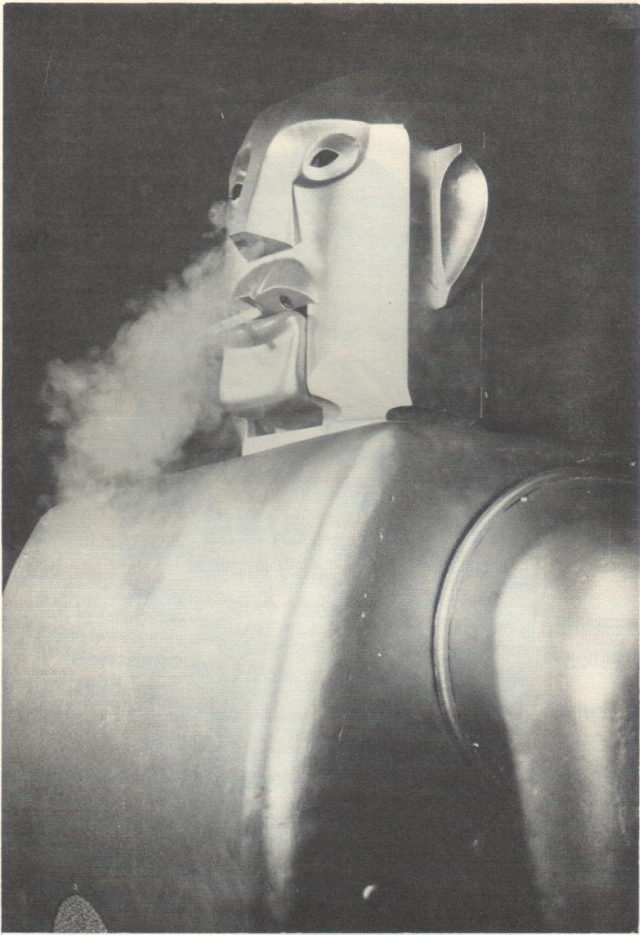
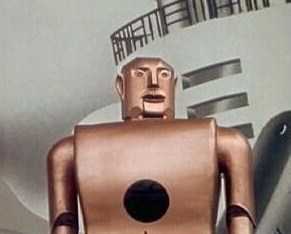
Colour photo of Elektro at the 1939-40 World's Fair held in New York.

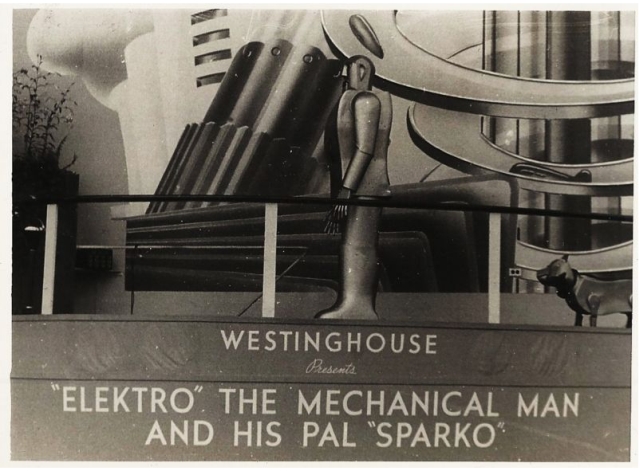
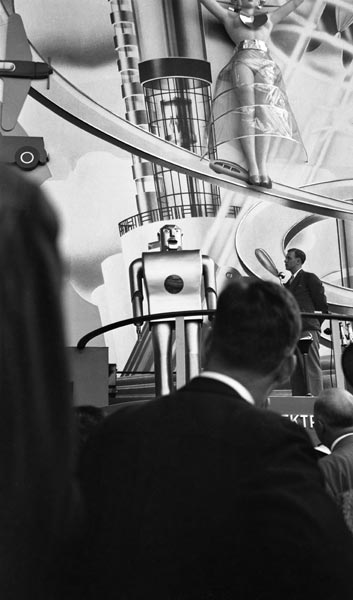
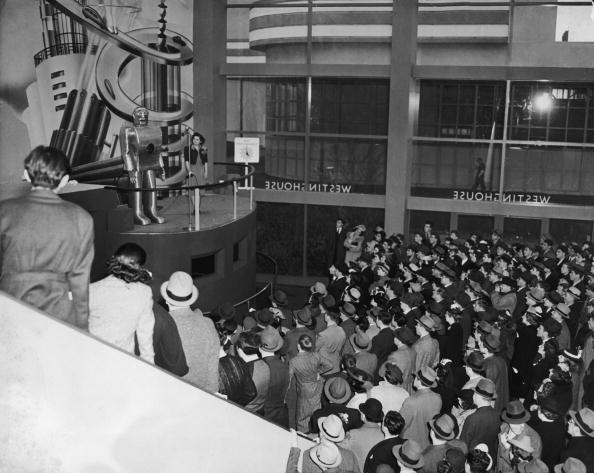
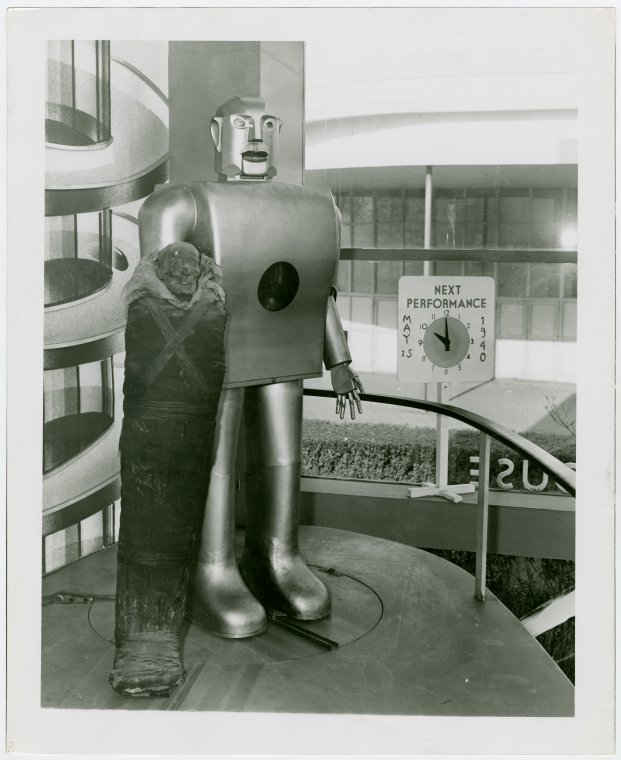
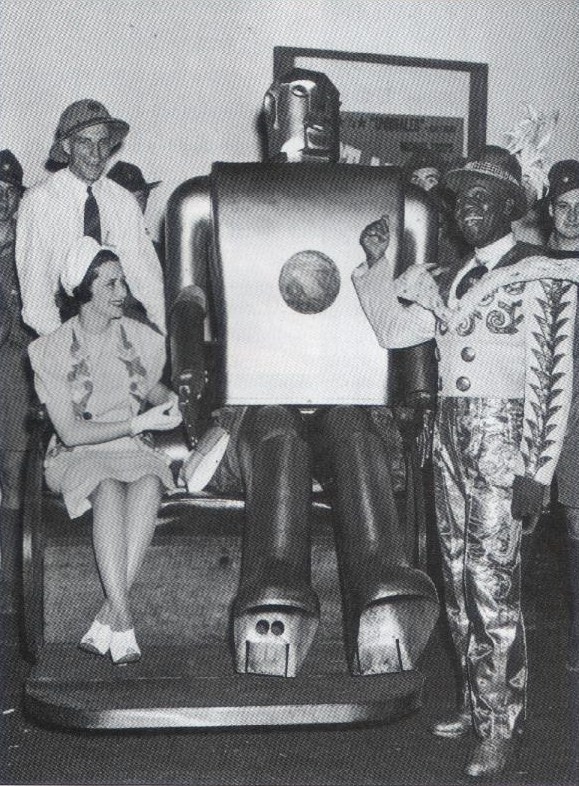
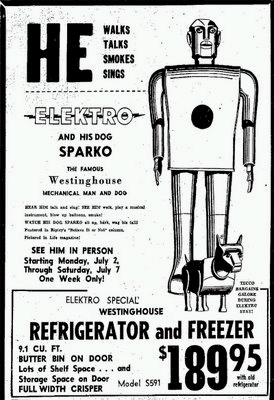
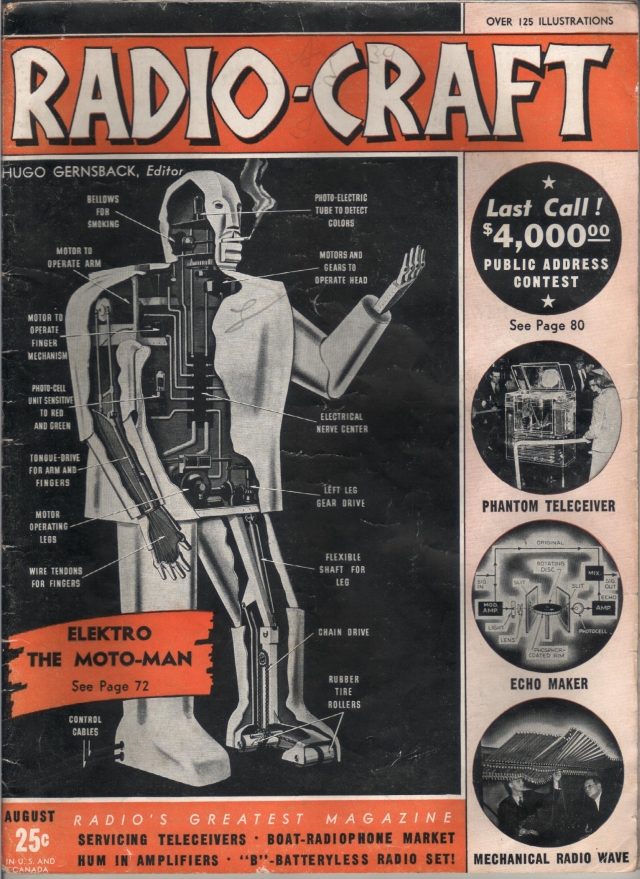
ELEKTRO- "the Moto-Man
This 260-lb. mechanical man at the New York World's Fair 1939 walks, talks, smokes, and selects colors! His anatomy includes an "electric eye," 48 relays, 11 motors, a microphone, grid-glow tube, and amplifiers.
THIS mighty automaton is never brain-weary because his brain lobes are 48 electrical relays. These devices do all the thinking for him; he merely obeys their promptings which are delivered through his nervous system of motors, levers, gears and chains. His spinal column is made of wire, and there's enough of it wound around his coils to encircle the world at the equator. His name?— "Elektro." He's "A Latin from . . . ." —Pittsburgh!
"INSIDE" STORY
He stands 7 ft. high in his aluminum feet and has an 82-inch chest expansion. His chest, however, is always expanded because, like the rest of his body, it is made of aluminum over a steel frame. His feet are 18 inches long and half as broad. His food he takes from the nearest light socket, for Elektro is an electrical robot. He's the Westinghouse "Moto-Man."
All told, Elektro has a bag of 26 tricks. He not only walks forward, but he can back up just as readily. He bows his head as prettily as a debutante or turns it 45 degrees in either direction to gape like a rowdy. If in the mood, he will bring either hand up to his face in a patriotic salute, and if properly coached he will raise his hands and count on his fingers, bending them one at a time in approved finger-counting style.
Elektro's favorite colors are red and green. As a matter of fact, they are the only colors he sees, and when they are flashed with a light before his eyes he speaks out "red" or "green" as the case may be.
However, Elektro is at his prodigious best when it comes to smoking. He not only puffs and inhales, but he blows the smoke in billows from both nostrils.
But frankly Elektro is a dullard by comparison with any man, and he can never hope to compete with human intelligence and muscular control. There are 292 different muscles in the human body, capable in combination of producing unestimated thousands of different movements beyond the 500 most elementary motions. On the basis of Elektro's 260-pound weight and 26 tricks, he requires about 10 pounds for every motion.
Elektro's "brain" weighs approximately 60 pounds and occupies more than 4 cubic feet of space outside the robot's body. The "brain" or control unit includes an "electric eye," 48 electric relays and signal lights, in addition to the controlling photo-electric cell. According to J. M. Barnett, the inventor of the Westinghouse "Moto-man," the "brain" alone would have to contain 1,026 electric relays in order to "think" for a robot capable of duplicating the 500 elementary human motions. It would then weigh nearly half a ton, and occupy about 108 cu. ft. of space! He is "bossed" by human commands spoken softly into a microphone, jumps to obey, although there is no visible connection between the microphone and the robot.
VOICE CONTROL
Spoken words set up vibrations which are converted into electrical waves by a grid-glow tube. The electric impulse then lifts a shutter in front of an electric lamp and sends a flash of light across the room to a photoelectric tube or "electric eye" in the control unit (not shown) which serves as Elektro's brain.
The "electric eye" acts as a sensory nerve. It receives the light command, translates it into a feeble electric current which is amplified and sent on to the bank of relays. The relays, which operate on the same magnetic principle that makes the front door bell ring, close and open electric circuits to start Elektro's motors turning.
Talking to Elektro is like dialing an automatic telephone, using light impulses instead of numbers to cause the relays to act. It makes no difference what words are used to give the command so long as the proper number of light impulses are produced.
One word or impulse places a series of relays in position to act. Two words close the electrical circuit and release current to the motors employed in any particular movement of the robot. Three words activate relays to stop Elektro, and 4 words bring all of the relays back to their normal position of rest.
Signal lights on the control panel inform the operator which movement of the robot is next in sequence. By speaking single words or a series of words properly spaced, the operator can cause the relays to skip over any number of these "points of motion." When the light flashes over the desired "point of motion" on the control panel, a 2-word command will start the proper relay.
Just as the "electric eye" converts light waves into electric currents to put life into the robot, two other "electric eyes" enable it to discern colors. These photoelectric cells are placed directly back of Elektro's glass eye. A filter in front of one tube lets only the relatively hot rays from red light through to the cell. A filter in front of the other tube permits only the relatively cool heat waves of green light to reach the tube. When the proper lights are flashed in Elektro's eyes, one or the other of these "electric
eyes" energizes a relay to start a record revolving on a turntable to produce the word —"red" or "green."
WALKING AND TALKING
Electro's walking is accomplished by of 4 rubber rollers under each foot which are driven by chains and shafts connected to a motor in the middle of the automaton. Nine motors are required to operate the fingers, arms, head and turntables for talking. Another small motor works the bellows for Elektro's smoking.
Like some radio programs, Elektro does his talking by means of transcriptions. His speech usually lasts about 1 minute and uses only 75 words. He has 8 turntables, each of which could be used to give 10-minute talks. Actually, except for an opening talk of about a minute, his other speeches will be only a few seconds long. A solenoid (a tubular coil) activated by electrical impulses in proportion to the harshness or softness of spoken words makes Elektro's aluminum lips move in rhythm to his speech-making.Automatons have indeed come a long way since Aristotle speculated upon the possibility of making mechanical men. Elektro's direct forebear is Willie Vocalite, a robot developed a few years ago in the Westinghouse research laboratories. Willie is voice-operated and can stand up and sit down, but he can't walk. Their common ancestor was named Televox, hut he responded only to sounds transmitted by telephone wires and went through life without an "electric eye."
These are actors on the stage of electrical living. The scientific principles which they dramatize are already quietly at work in industry. The Televox has now supplemented supervisory control in power transmission systems, enabling the system dispatcher to reroute the supply of electricity when a power line has been damaged. The "electric eye" and relays are employed in countless tasks of sorting, counting, and regulating, freeing human hands from monotonous and dangerous tasks. The sole reason for making Elektro was to dramatize the action of these sensitive electrical devices.
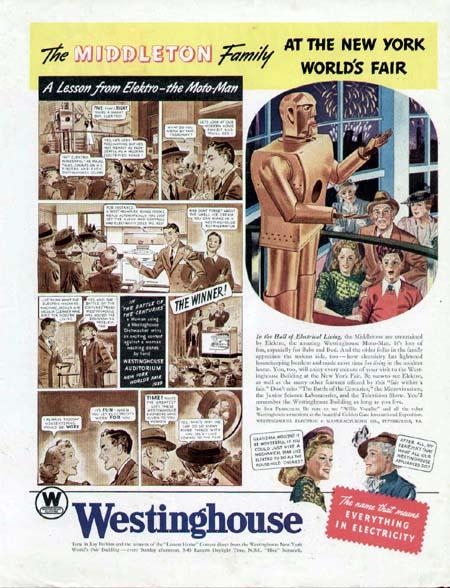

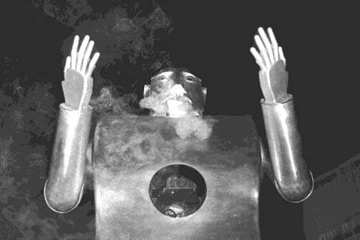
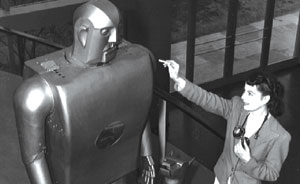
Elektro at the World's Fair. The start of a smoking habit. It's always a woman tempting him.
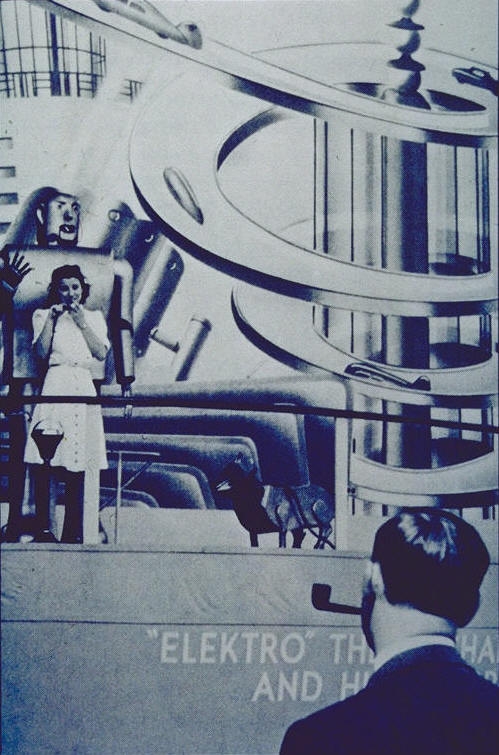
Elektro with Sparko.
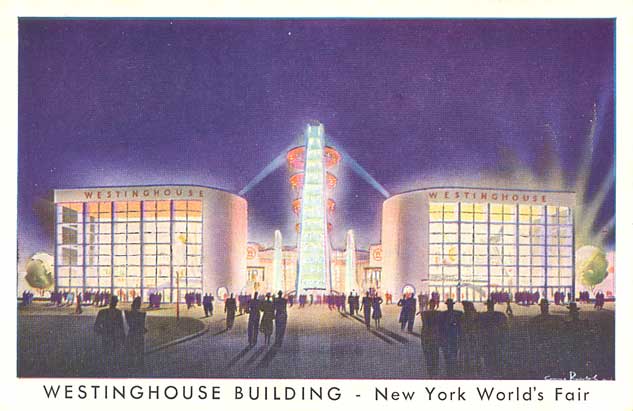
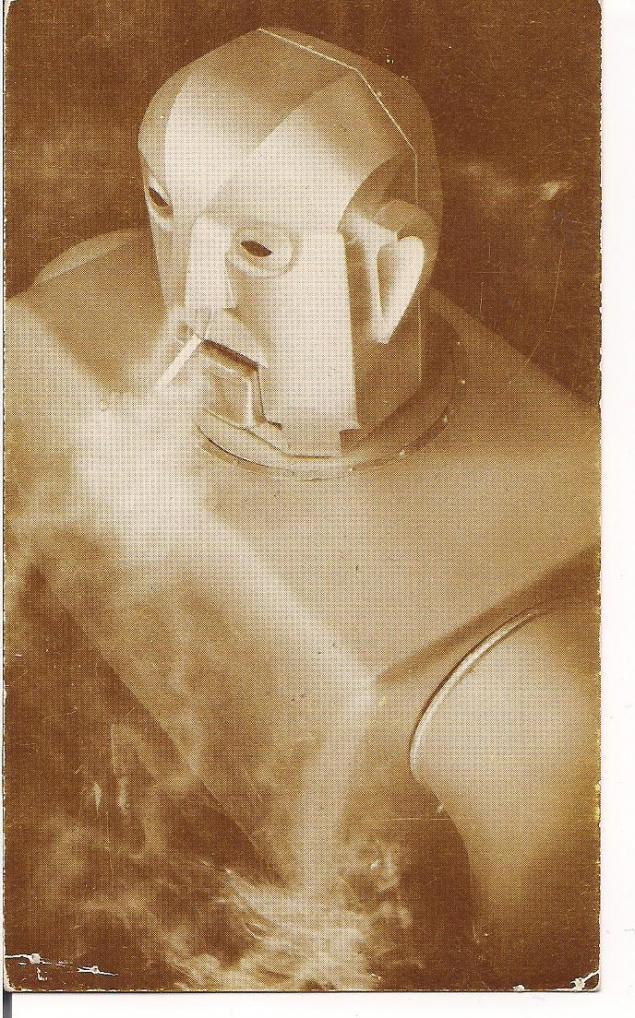
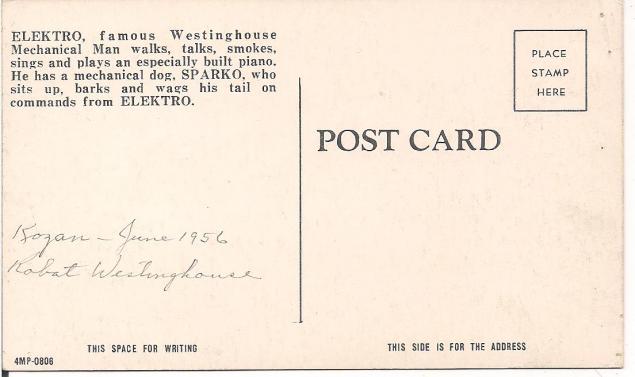
Post card from 1956. Its the only mention of an especially built piano for Elektro that I'm aware of.
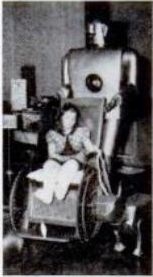 Elektro and Sparko did a lot of hospital visiting.
Elektro and Sparko did a lot of hospital visiting.
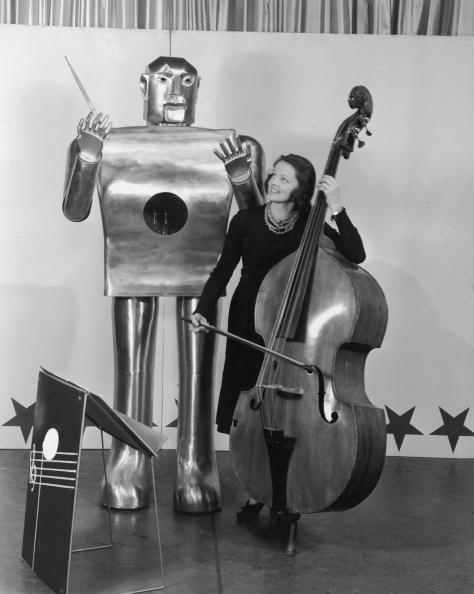
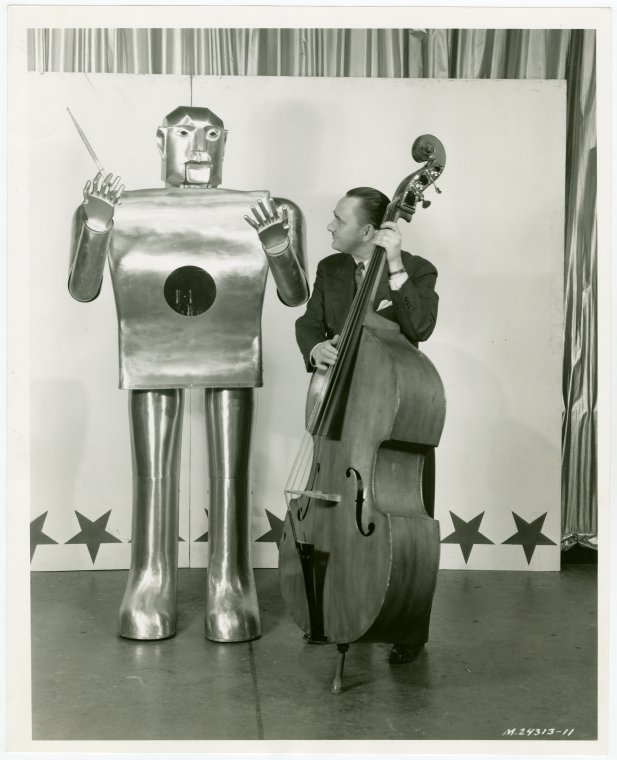
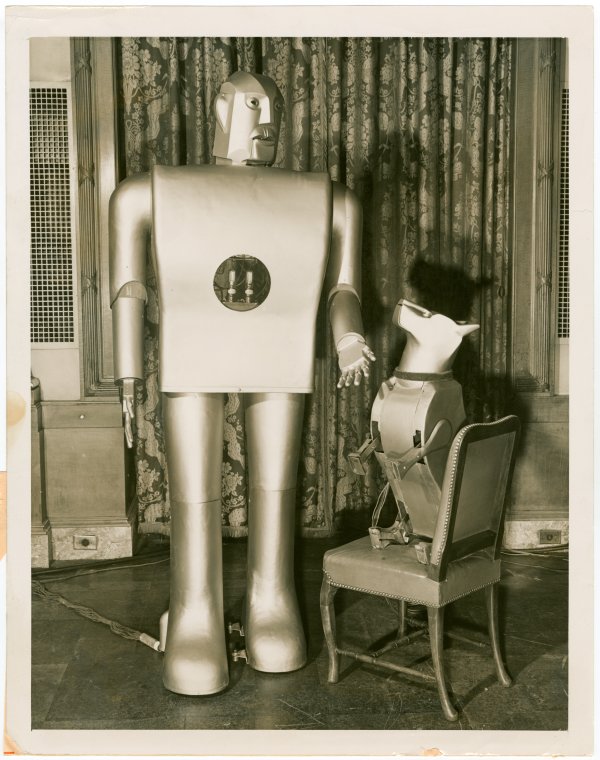
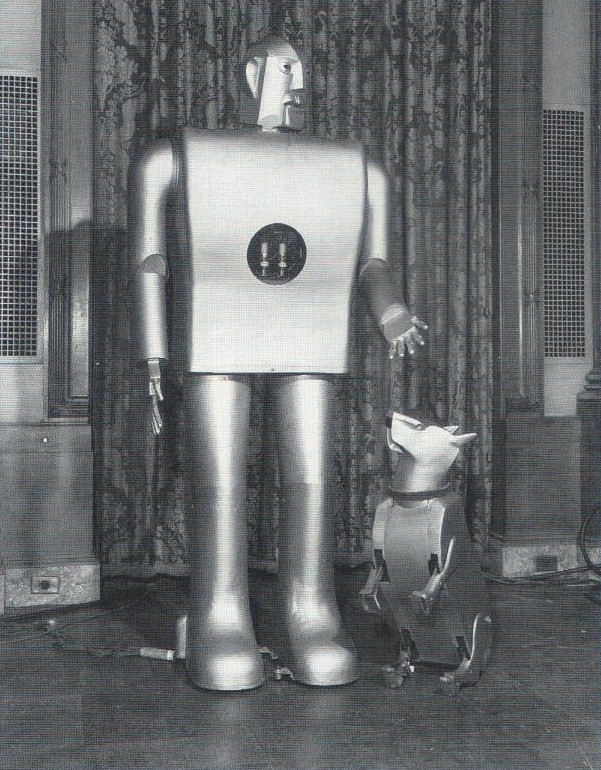
Like his predecessors, most of the electronics were located off-stage.
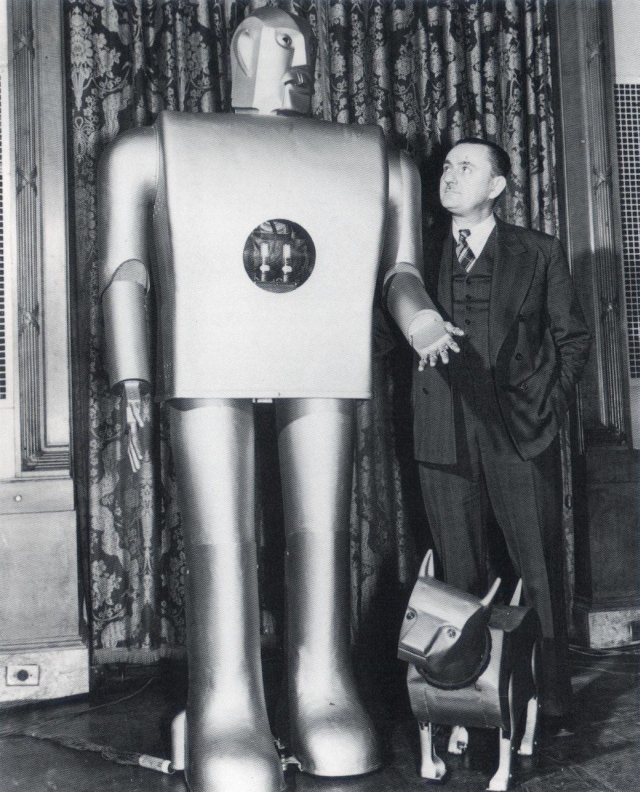
above: Happy family: Elektro, Sparko and their creator, Barney Barnett.
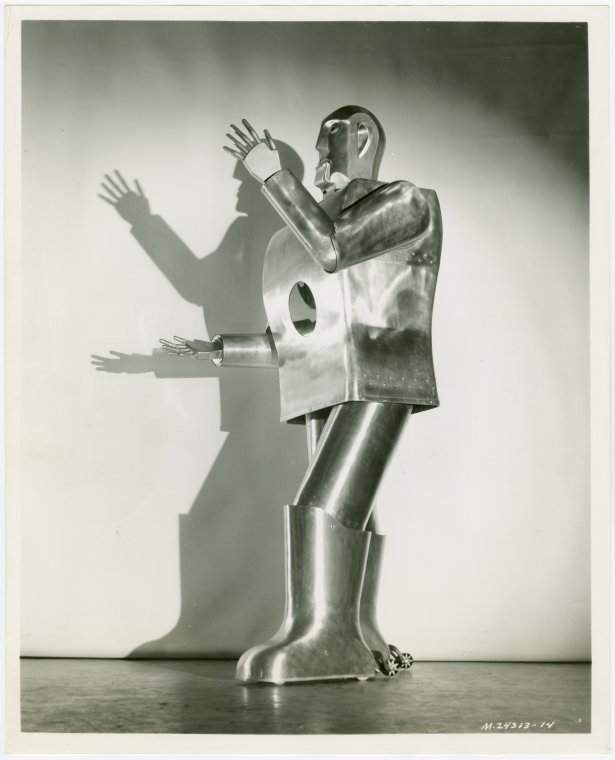

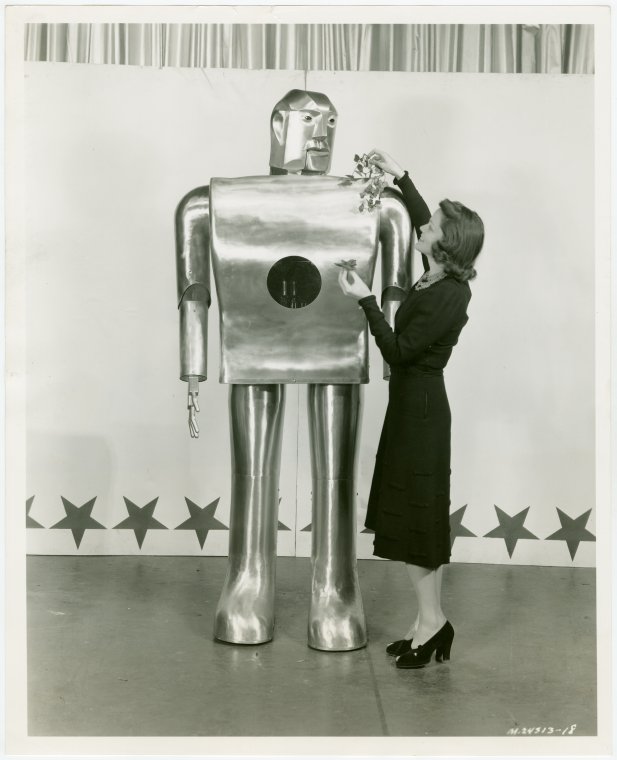
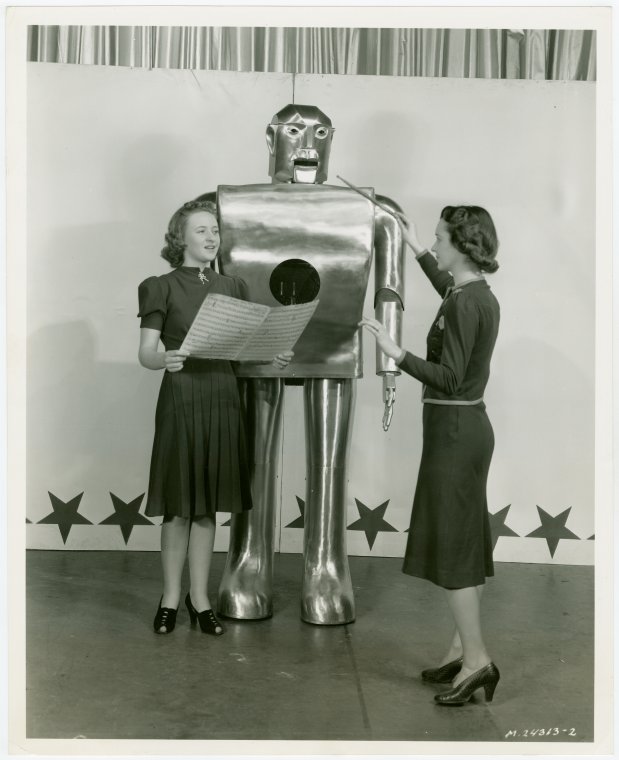

above: John Angel was the operator of Elektro in 1949.
It was said that Operators of Elektro had to clean out the cigarette tar from the tubing at the end of each performance, putting them off from smoking.
above: "Hi, pal!" says Mr. Elektro to J. M. Barnett, his creator. Three years were spent perfecting the mechanism which performs 36 tricks for visitors at the New York World's Fair 1939.
"Oil on the knee" is Mr. Elektro's affliction, but it is also an aid to his locomotion. Elektro's walking mechanism is given the once-over.
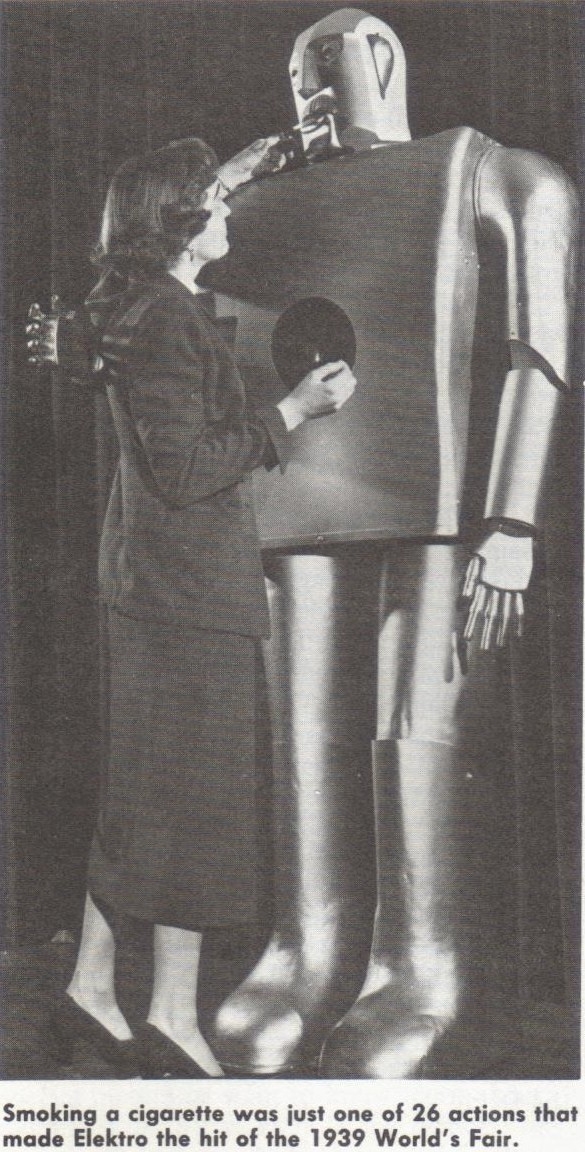
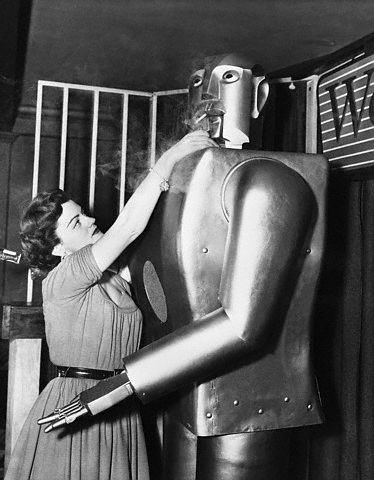
Elektro with Jean Dowling in 1954.
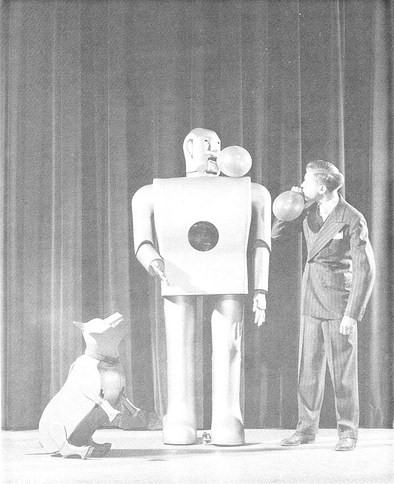
An attempt to get Elektro off smoking. The balloon trick was a later addition from 1941.
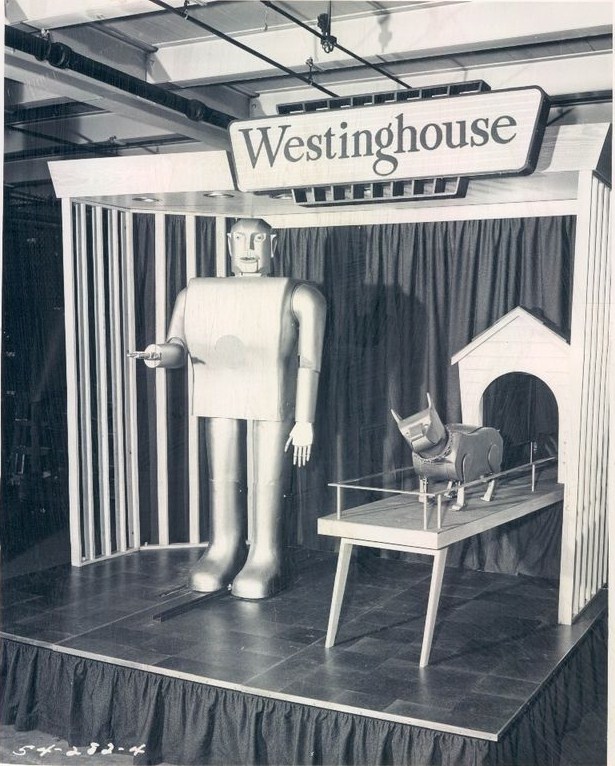
Elektro and Sparko in Chicago, 1955.
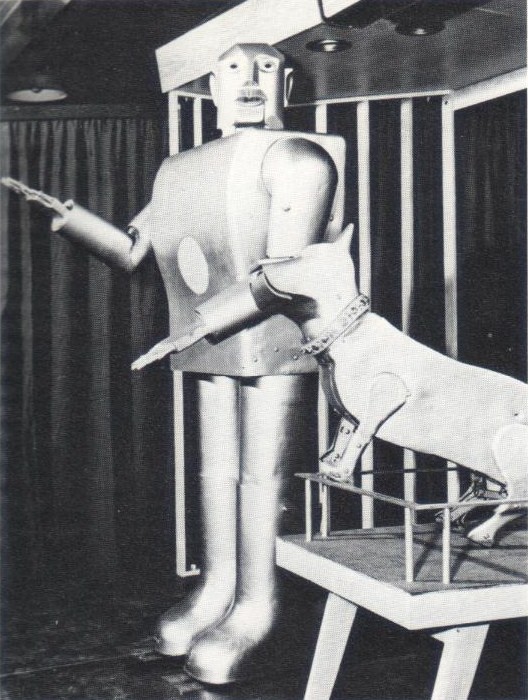

above: After some time in retirement, Elektro was shipped to Westinghouse's pavillion for Pacific Ocean Park in 1957 for the official opening in 1958. He was painted silver and had the chest hole squared off. He wasn't there long before becoming a movie star in "Sex Kittens" (see below).
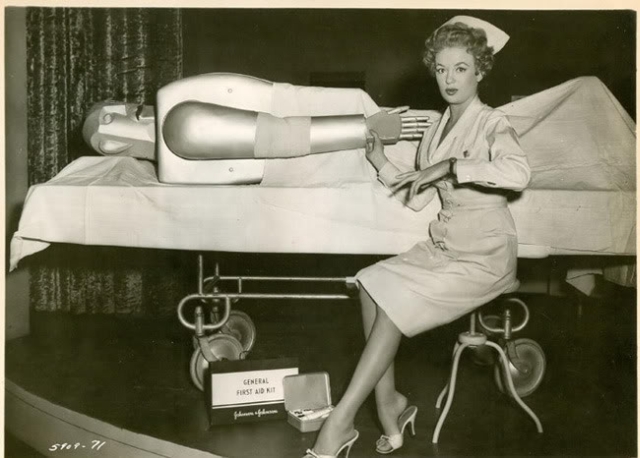
"Sam Thinko" (Sequential Auxilliary Modulator) from "Sex Kittens Go to College". The motors to Elektro's legs had gone by this stage. See trailer clip here.
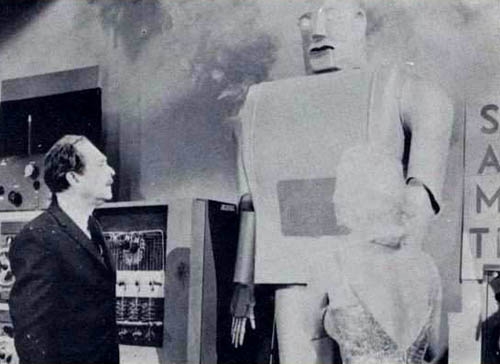
below: As he is today (2004)
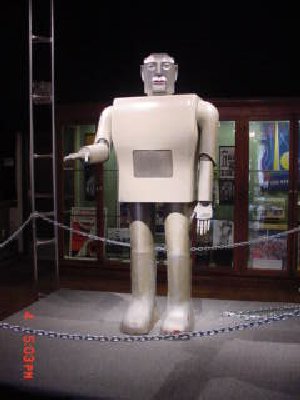
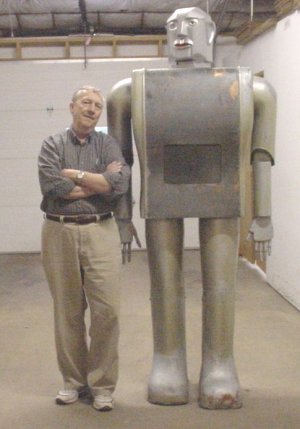
see Jack Weeks archive with photos here.
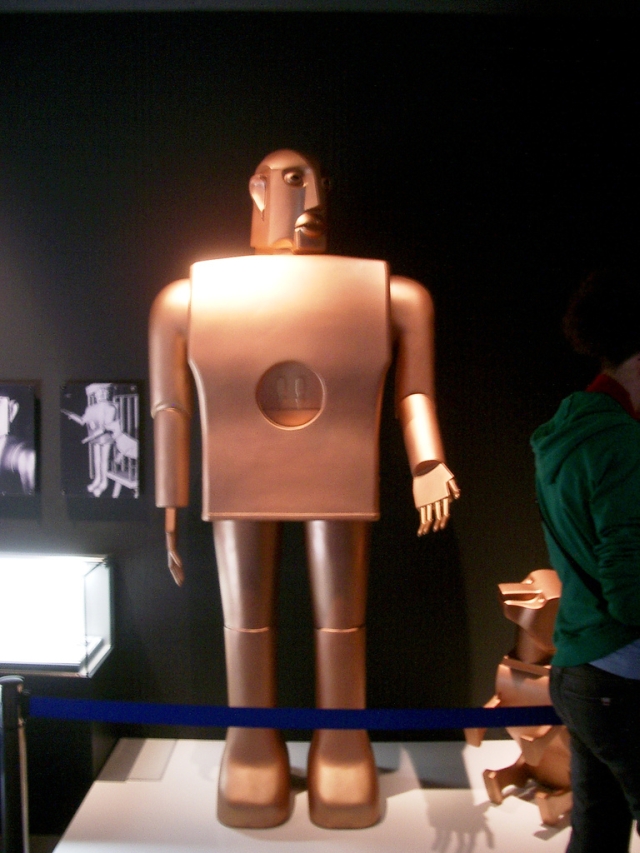
A Japanese copy made for the now defunct Robot Museum in Nagoya, Japan. 2007.
Scott Schaut's excellent book on Westinghouse robots ("Robots of Westinghouse – 1924 – today", 2006) gives a lot of detail and more pics which I wont include in this post.
For VIDEO CLIPS – see here , here and here.
Here is a description of how the Operator interacts with Elektro. It is based on the video clip of Elektro at the 1939 World's Fair in New York.
Operator: "And so, Ladies and Gentlemen, with a great deal of pride and pleasure I present to you Elektro – the Westinghouse Moto-Man."
He puts the handset mouthpiece to his mouth and says, "Elektro ..(takes handset away for a second, then back up to his mouth again.
"Come…Here…" (as two distinct words with a slight pause between them. You cannot see the lamp inside Elektro's chest at this time.) You can here the humming sound of the motors as Elektro starts to move forward. He is actually being guided on a track embedded in the stage. The track ends in a turntable.
With the handset away from his mouth, he says, "And here he comes, Ladies and Gentlemen, walking up to greet you under his own power."
Once Elektro reaches the turntable some seconds later (or ~3 steps), the Operator holds the handset to his mouth again and says,"Stop."
Now on the turntable, the Operator manually rotates him to front the audience.
With the handset away from his mouth, the Operator says, "You see, all I need to do is speak into this phone, and Elektro does exactly what I tell him to do, some times."
He continues , " but I don't see why I'm telling Elektro's story when he's perfectly able to tell his own. So let's listen and see what Elektro has to say to us today. All right Elektro.." Now the handset is place to the Operators mouth.
"Will..you..tell (three syllables)…. your(one syllable)…. story..please?(two syllables" Note: The 6-impulse vvoic ccode (3-1-2 wus o start all of Elekto's "tricks".
The handset is now taken away.
Elektro: "Who.. me..?" Note: there is a pause in Elekto's pre-recording that allows time fo the Opeator's response.
Operator: "Yes, you."
Elektro: "OK, toots." (gets a laugh from the crowd. A lot of the time it was a female presenting, so the script was not for a male Operator.)
Elektro: (in a now classic "robotic" monotonic, monosyllabic voice) "Ladies and Gentlemen, I'll be very glad to tell my story. I am a smart fellow as I have a very fine brain of 48 electrical relays. It works just like a telephone switchboard. If I get a wrong number, I can always blame the Operator…"
Operator: "Thank you". Gets a laugh from the crowd.
Elektro: "And by the way, I see a lot of good numbers out in our audiance today. (another laugh from the crowd).
Operator: "Elektro, behave yourself!"
Elektro: "Quiet please, I'm doing the talking!"
Operator: "I'm sorry. (break in film clip and Elektro now has his right hand raised to his face.) Now Elektro, a moment ago you were bragging about being able to count on your fingers. Do you remember that? Well we're going to find out about that. Now, do you remember how many children were born at the same time to a certain family up in Campbell?. Do you remember that? All right, let's see if you do."
One can now see the lamp inside of Elektro's chest, indicating each syllable signal when flashed.
"Count..them..on (lamp flashes 3 times – once per syllable) ….your(single flash)…. right hand.(two flashes)" Note: Again, this is the (3-1-2) code used to start any of Elektro's "tricks".
With the handset away from his mouth, the Operator counts the movement of each finger, from the little finger to the thumb), "one , two, three, four," and just before uttering the next word, the Operator places the handset to his mouth and says, "five. (a single flash)"
Note: A single impulse is used to stop any command. In this case, there is a rotary motor-driven cam inside of Elektro's hand that, via a lever, pulls a cable that bends each finger in turn. This would repeat until Elektro was commanded to stop.
The handset is lowered.
Operator: "Five. Well that's absolutely correct."
(another cut in the film clip – hand is now lowered)
Operator: "Alright now Elektro, I know you enjoy these and I'm really going to try give
you a nice pleasure out of these, so here you are."
Operator places cigarette in Elektro's mouth – actually a hole in Elektro's upper lip.
Operator: "You got that? Now hold onto them."
Operator places the handset to his mouth, "You may..now..smoke(3 flashes)……this..cigarette(two flashes)…….go..on(two flashes)." The handset is put down.
Operator: "Oh, yes, Elektro, you need a light don't you? Here you are." and he lights the cigarette and you can see the cigarette smoke coming out of his nostrils.
"And folks, he's only two years old, too, just learning." (referring to Elektro's smoking action).
END
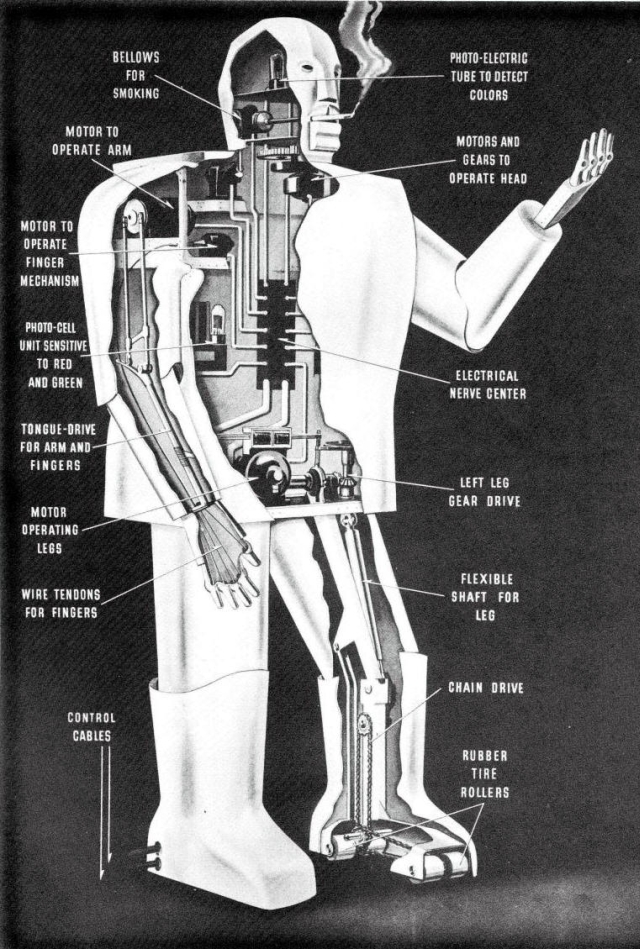
New and old memorabilia
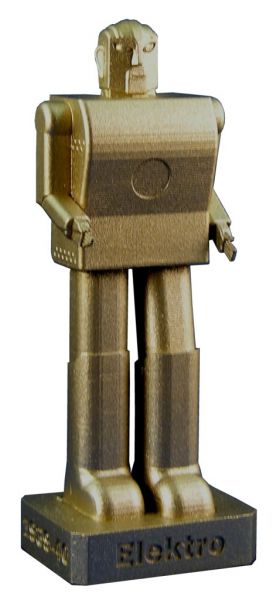
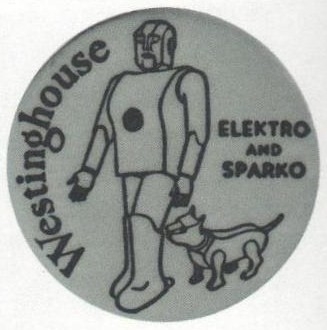
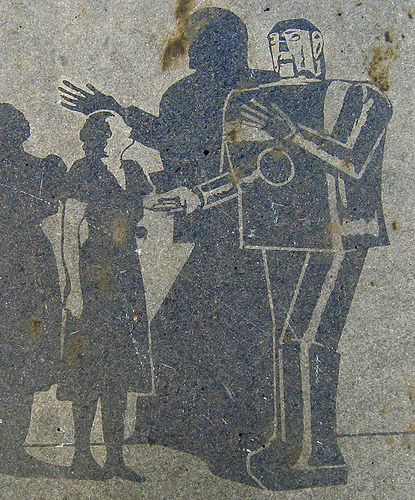
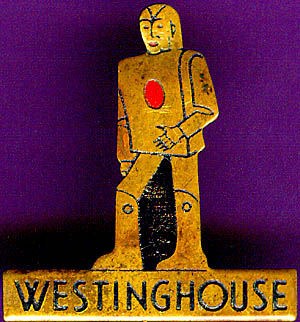
Trivia: I have not, to date, seen any Westinghouse publicity information calling Elektro et al "Robots". They are largely referred to as a "Mechanican Man", "Moto-Man" in Elektro's case, or "Electronic Dog" in Sparko's case.